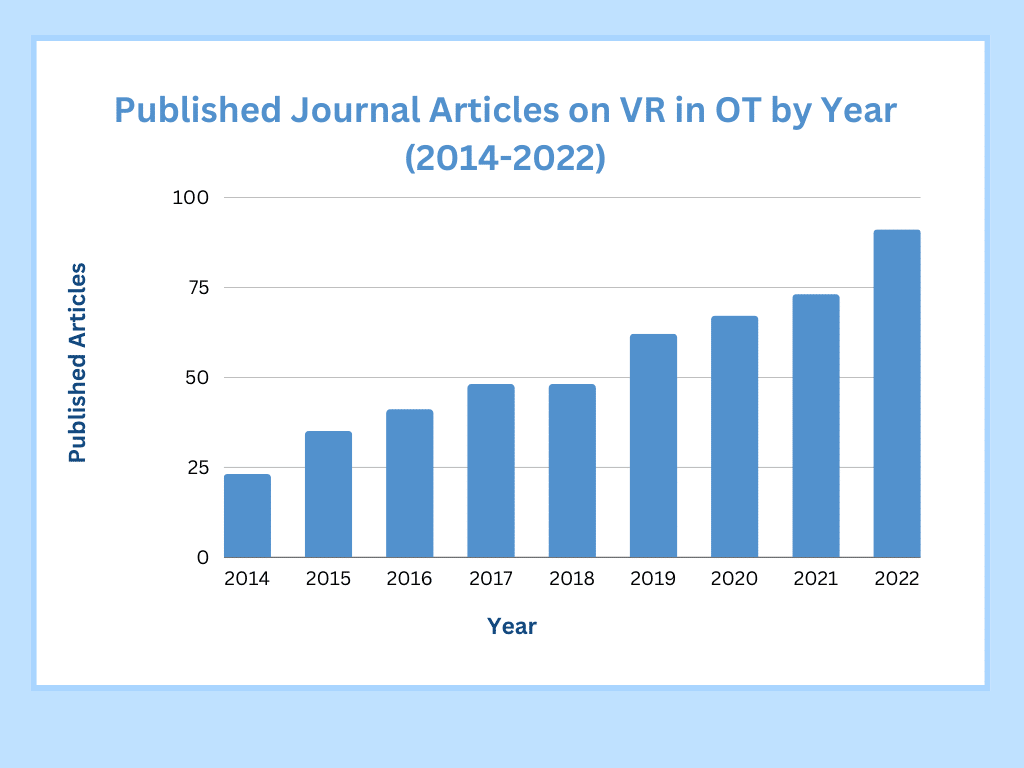Research into the benefits of virtual reality (VR) in occupational therapy has exploded over the past years. The graph below provides a summary of the literature articles a simple PubMed search of virtual reality in occupational therapy. With the increase in research, how are occupational therapists using virtual reality? We have explored three areas where using virtual reality in occupational therapy can improve outcomes backed by evidence.

Stress and Anxiety Management
According to the American Psychological Association (2022), three-quarters of adults have experienced health impacts due to stress within the last one month. VR can provide therapists a tool to tacle these issues by exposing clients to controlled stressors in a safe environment. According to several studies, OT practitioners can gradually introduce stressful scenarios, like crowded places or social interactions, to help clients build confidence and improve coping skills. VR also offers relaxation and mindfulness exercises to help you manage stress and anxiety.
A recent scoping review explored how Head-Mounted Display VR (HMD-VR) treats anxiety disorders and how these findings can benefit occupational therapy’s psychosocial practice. The scoping review delved into 28 studies using HMD-VR for exposure therapy and found that 17 reported positive outcomes. However, some studies didn’t show a significant difference between standard care and VR-based treatment, possibly because the VR stimuli needed to feel more realistic.
Enhancing Upper-Extremity Function
A novel approach that has emerged in stroke rehab is the integration of VR and movement sensors to assess and improve upper extremity function. Stroke survivors are often left with hemiparesis, which impedes their ability to perform activities of daily living (ADLs). Powered by VR, home-based therapy programs show promise in addressing these challenges. A recent study employed this technology, using the Microsoft Kinect® sensor, to engage post-stroke individuals in a customized VR game, “Mystic Isle,” tailored to their rehabilitation goals. The results were promising: significant differences in kinematic measures were observed between stroke survivors and healthy individuals. This groundbreaking research not only quantified upper extremity movement but also demonstrated the sensitivity of these measures in detecting deviations from normative values. As VR tools become increasingly prevalent in clinical practice, occupational therapy practitioners are poised to harness this technology for more effective assessments and interventions, ultimately enhancing the rehabilitation journey for stroke survivors.
Pain Management and Distraction Therapy
The realm of pain management in occupational therapy is undergoing a transformative shift driven by the accessibility of affordable virtual reality (VR) technology. With billions of dollars invested in advancing VR and augmented reality products, these consumer-ready immersive technologies are poised to revolutionize therapeutic approaches, particularly in hand therapy. VR’s immersive nature offers remarkable benefits, significantly reducing patients’ pain levels during hand therapy sessions making engaging in crucial hand and finger movements less discomfort.
Furthermore, gamified virtual reality introduces an element of fun and motivation into therapeutic hand exercises, encouraging patient participation. VR also holds the potential to monitor and assess the efficacy of hand therapy exercises, ensuring adherence to treatment regimens and enhancing long-term functionality. This dynamic fusion of VR and occupational therapy, spanning both acute and persistent pain patient populations, underscores the need for continued research and development in harnessing virtual reality as an invaluable tool for hand therapists. The future of pain management and rehabilitation is becoming increasingly immersive, engaging, and promising.
Key Takaways
In the realm of occupational therapy and virtual reality (VR), three key areas stand out with evidence-backed benefits:
- Stress and Anxiety Management: VR helps therapists tackle stress and anxiety by exposing clients to controlled stressors in a safe environment. Recent studies suggest promising outcomes, although realism in VR stimuli needs improvement.
- Stroke Rehabilitation: VR, combined with movement sensors, offers customized rehabilitation games for stroke survivors. This approach quantifies progress effectively and enhances assessments and interventions.
- Pain Management: Affordable VR technology is transforming pain management in occupational therapy. It reduces pain during therapy, adds motivation through gamification, and monitors treatment effectiveness.
In summary, VR is proving a valuable tool in occupational therapy. It offers an innovative treatment options for stress management, upper-extremity rehab, and pain relief. The long-term adoption of these treatment modalities can’t be fully predicted. however, with advances in consumer VR devices from the likes of Meta and Apple, we can best predict OT using VR will continue.
Resources
- Donnelly MR, Reinberg R, Ito KL, Saldana D, Neureither M, Schmiesing A, Jahng E, Liew SL. Virtual Reality for the Treatment of Anxiety Disorders: A Scoping Review. Am J Occup Ther. 2021 Nov 1;75(6):7506205040. doi: 10.5014/ajot.2021.046169. PMID: 34817595; PMCID: PMC8742249.
- Hoffman, H. G., Boe, D. A., Rombokas, E., Khadra, C., LeMay, S., Meyer, W. J., Patterson, S., Ballesteros, A., & Pitt, S. W. (2020). Virtual reality hand therapy: A new tool for nonopioid analgesia for acute procedural pain, hand rehabilitation, and VR embodiment therapy for phantom limb pain. Journal of hand therapy : official journal of the American Society of Hand Therapists, 33(2), 254–262. https://doi.org/10.1016/j.jht.2020.04.001
- Proffitt, R., Ma, M., & Skubic, M. (2023). Novel clinically-relevant assessment of upper extremity movement using depth sensors. Topics in stroke rehabilitation, 30(1), 11–20. https://doi.org/10.1080/10749357.2021.2006981
